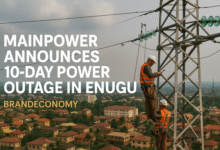
Nigeria’s long-running struggle with electricity supply has once again been thrown into sharp relief. On September 28, 2025, the Nigerian Independent System Operator (NISO) confirmed that the nationwide strike declared by the Petroleum and Natural Gas Senior Staff Association of Nigeria (PENGASSAN) triggered a reduction of more than 1,100 megawatts (MW) from the national power grid.
This dramatic fall — from over 4,300MW in the early hours of the day to just about 3,200MW at its lowest point — highlights the dangerous interconnection between Nigeria’s labour disputes, energy supply chains, and fragile electricity infrastructure. More worryingly, it underscores how vulnerable the grid remains to shocks in the gas-to-power value chain.
With hydropower stations rushing to fill the gap, and selective load-shedding applied nationwide to stave off total collapse, the episode raises urgent questions for policymakers, investors, and consumers alike: How secure is Nigeria’s power future? What risks do labour disputes pose to energy supply stability? And what lessons can the market draw from this latest flashpoint?
The Crisis Explained
According to NISO, the labour action within the gas supply chain, tied to PENGASSAN’s ongoing dispute with Dangote Refinery, triggered widespread gas shortages across key thermal plants. Gas-fired plants account for over 70% of Nigeria’s electricity generation, making disruptions in supply particularly catastrophic for the national power grid and electricity supply.
To mitigate the crisis, NISO rolled out a series of emergency interventions:
- Hydropower Optimisation: Strategic ramp-ups from Kainji, Jebba, and Shiroro added 400MW of additional output to cushion the collapse from gas-fired plants.
- Real-Time Load Balancing: Load adjustments and redispatching across regions to match reduced generation with demand.
- Voltage and Frequency Support: Reactive power compensation and reserve monitoring to prevent collapse.
- Selective Load Shedding: A last-resort strategy deployed to preserve operational security and keep critical infrastructure supplied.
The agency’s quick actions averted a nationwide blackout, but the crisis once again exposed the razor-thin margins under which Nigeria’s power sector operates.
Sectoral Implications
1. Power Sector Stability
The grid’s heavy reliance on gas-fired generation makes it acutely vulnerable to upstream labour disputes and industrial actions. With gas plants already struggling under low investment, poor infrastructure, and frequent pipeline vandalism, the strike highlighted the urgent need for diversification into renewables and more resilient energy systems.
2. Labour Relations and Industrial Disputes
The crisis illustrates the ripple effect of unresolved labour disputes. PENGASSAN’s quarrel with Dangote Refinery — over the alleged sacking of over 800 workers — cascaded beyond oil and gas into electricity. If not resolved, similar disputes could continue to threaten national energy stability.
3. Manufacturing and Industry
The 1,100MW shortfall meant manufacturers faced load shedding and energy rationing. For Nigeria’s struggling industrial base, already hit by foreign exchange shortages and inflation, this disruption translates directly into higher costs, reduced productivity, and weaker competitiveness.
4. Households and SMEs
Consumers, especially SMEs reliant on the grid for affordable electricity, faced extended outages. Many turned to diesel and petrol generators, amplifying operating costs at a time when fuel prices remain elevated.
5. Financial Markets
Investors view power stability as a critical enabler of growth. This episode may reinforce concerns about Nigeria’s investment climate, particularly in power generation, transmission, and distribution. The reliability of supply chains remains central to attracting capital.
Investor and Economic Implications
- Energy Investment Risks: The crisis underscores systemic risks in Nigeria’s gas-to-power model. Investors may demand clearer guarantees and dispute-resolution mechanisms before committing funds to gas, thermal, or infrastructure projects.
- Renewable Energy Upside: The volatility highlights opportunities for investors in solar, wind, and mini-grid solutions. By diversifying energy sources, Nigeria can reduce exposure to single-point failures in the gas supply chain.
- Macroeconomic Costs: Every MW lost translates to lost GDP. Nigeria’s current energy gap is estimated to cost the economy $25–30 billion annually in foregone output. The 1,100MW shortfall during this strike added another dent to productivity and revenue.
- Public Finance and Policy: The Federal Government, already under pressure from subsidy reforms and high debt service costs, faces fresh urgency to address structural weaknesses in energy policy. The mediation between PENGASSAN and Dangote Refinery will also test government’s ability to manage disputes that risk escalating into national crises.
BRANDECONOMY Takeaways for Stakeholders
- For Policymakers: Energy diversification is no longer optional. Nigeria must fast-track investment into renewables, gas infrastructure, and storage to build resilience.
- For Labour and Industry: Disputes in one sector now have cross-sector consequences. Dialogue, arbitration, and proactive dispute resolution are critical.
- For Investors: Risk assessments must account for political, labour, and infrastructural vulnerabilities in the energy value chain. Renewable and decentralised solutions remain high-potential entry points.
- For Manufacturers and SMEs: Energy security strategies — including backup generation and renewable adoption — are essential for business continuity.
- For Consumers: The reliability of power remains tied not just to technical fixes, but also to governance and industrial relations. Advocacy for reform must include citizen voices.











